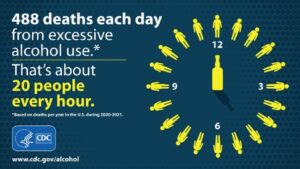The Death Toll from Alcohol
 The number of celebrities who died from substance abuse are legion, including: Elvis Presley, Hank Williams, Marilyn Monroe, and Jackie Wilson. There’s even a so-called “27 club” of entertainers who died at the age of 27 from substance abuse: Janice Joplin, Jimi Hendrix and Jim Morrison are members. But Curt Cobain is not a member, since he died from a heroin overdose and a self-inflicted gunshot wound at 28. And in October 2023, there was Matthew Perry’s accidental death from ketamine. But celebrities have also overdosed and died from alcohol. To name just a few, there’s: Billie Holiday, Amy Winehouse, David Cassidy and the British actors Oliver Reed and Richard Burton.
The number of celebrities who died from substance abuse are legion, including: Elvis Presley, Hank Williams, Marilyn Monroe, and Jackie Wilson. There’s even a so-called “27 club” of entertainers who died at the age of 27 from substance abuse: Janice Joplin, Jimi Hendrix and Jim Morrison are members. But Curt Cobain is not a member, since he died from a heroin overdose and a self-inflicted gunshot wound at 28. And in October 2023, there was Matthew Perry’s accidental death from ketamine. But celebrities have also overdosed and died from alcohol. To name just a few, there’s: Billie Holiday, Amy Winehouse, David Cassidy and the British actors Oliver Reed and Richard Burton.
The World Health Organization (WHO) recently reported in their “Global status report on alcohol and health treatment of substance use disorders” that 2.6 million deaths were attributable to alcohol consumption, accounting for 4.7% of all deaths. Of these, the WHO reported 1.6 million deaths were from noncommunicable diseases such as liver diseases, heart diseases cancers, and others. There were 700,000 deaths from injuries and another 300,000 from communicable diseases. Another estimated 400 million (7% of the world’s population aged 15 years and over) live with alcohol use disorders. The highest levels of consumption were seen in the WHO European Region (9.2 liters) and the Region of Americas (7.5 liters).
The level of alcohol consumption per capita among drinkers amounts on average to 27 grams of pure alcohol per day, roughly equivalent to two glasses of wine, two bottles of beer (33cl) or two servings of spirits (4cl). This level and frequency of drinking is associated with increased risks of numerous health conditions and associated mortality and disability.
In 2019, 38% of current drinkers had engaged in heavy episodic drinking, defined as consuming at least 60g of pure alcohol on one or more occasions in the preceding month – roughly equivalent to 4 or 5 glasses of wine, bottles of beer or servings of spirits. Continuous heavy drinking was highly prevalent among men.
Globally, 23.5% of all 15–19 year-olds were current drinkers. Rates of current drinking were highest among 15–19-year-olds in the European region (45.9%) followed by the Americas (43.9%).
There were an estimated 474,000 deaths from cardiovascular diseases in 2019 from alcohol consumption. And alcohol consumption increases the risk for several cancers, including breast, liver, head and neck, oesophageal and colorectal. “In 2019, 4.4% of cancers diagnosed globally and 401,000 cancer deaths were attributed to alcohol consumption.” There were 298,000 deaths from alcohol-related road crashes in 2019—156,000 caused by someone else’s drinking. Other injuries include falls, drowning, burns, sexual assault, intimate partner violence and suicide.
The WHO said there was no form of alcohol consumption that is risk-free. “The level of risk depends on several factors, including the amount consumed, frequency of drinking, the health status of the individual, age, sex, and other personal characteristics, as well as the context in which alcohol consumption occurs.”
Alcohol Deaths in the U.S.
Statistics on deaths in the U.S. from excessive alcohol use reported by NIH and the CDC aren’t a reason for optimism, as this article’s CDC graphic indicates. The NIH estimated there were more than 178,000 deaths (120,00 males and 59,000 females) attributable to excessive alcohol use in 2020-2021. An analysis of death certificates from 2019 to 2020 indicated deaths involving alcohol rose 25.5%, from 79,000 to 99,000. In 2022, alcohol-impaired driving fatalities accounted for 32% of overall driving fatalities, 13,524 deaths. Citing CDC estimates, 21% of all deaths by suicide have a blood alcohol level at or above .1%.
The CDC indicated the 178,000 deaths due to excessive alcohol use in 2020-2021 was a 29% increase over 2016-2017. “This shortened the lives of those who died by an average of 24 years.” One-third of these deaths were from binge drinking or drinking too much on one occasion. Deaths increased among all age groups. They usually involved adults 35 and older, but also included around 4,000 under the age of 21.
In a CDC Morbidity and Mortality Weekly Report (MMWR), Esser et al said 100% alcohol-attributable causes of death have increased over the past 20 years in the U.S. They noted the onset of the COVID-19 pandemic as a specific causative factor. Also see “The Unseen Surge of Alcohol Use.” Deaths among males from excessive alcohol use increased 26.8% from 2016-2017 to 2020-2021 and 34.7% among females.
From 2016–2017 to 2020–2021, the average annual number of U.S. deaths from excessive alcohol use increased by more than 40,000 (29%), from approximately 138,000 per year (2016–2017) to 178,000 per year (2020–2021). This increase translates to an average of approximately 488 deaths each day from excessive drinking during 2020–2021. From 2016–2017 to 2020–2021, the average annual number of deaths from excessive alcohol use increased by more than 25,000 among males and more than 15,000 among females; however, the percentage increase in the number of deaths during this time was larger for females (approximately 35% increase) than for males (approximately 27%). These findings are consistent with another recent study that found a larger increase in fully alcohol-attributable death rates among females compared with males.
Increases in deaths from excessive alcohol use during the study period occurred among all age groups. A recent study found that one in eight total deaths among U.S. adults aged 20–64 years during 2015–2019 resulted from excessive alcohol use. Because of the increases in these deaths during 2020–2021, including among adults in the same age group, excessive alcohol use could account for an even higher proportion of total deaths during that 2-year period. In addition, data from Monitoring the Future, an ongoing study of the behaviors, attitudes, and values of U.S. residents from adolescence through adulthood, showed that the prevalence of binge drinking among adults aged 35–50 years was higher in 2022 than in any other year during the past decade; this increase could contribute to future increases in alcohol-attributable deaths. In this study, fewer than one third of deaths from excessive alcohol use were from fully alcohol-attributable causes, highlighting the importance of also assessing partially alcohol-attributable causes to better understand the harms from excessive drinking, including binge drinking.
The increases in alcohol-related deaths have several contributing factors. “These include the availability of alcohol, increases in people experiencing mental health conditions, and challenges in accessing health care.” Esser et al said during the peak of the COVID-19 pandemic in 2020-2021, places that sold alcohol were considered essential businesses in many states; and remained open during lockdowns. There were also delays in seeking medical attention, including avoiding emergency departments for alcohol-related conditions. Stress, loneliness, and social isolation may have also contributed to the increase of deaths from excessive alcohol use during the COVID-19 pandemic.
Entering the 27 Club
Amy Winehouse’s hit song, “Rehab,” was on her second and final studio album Back to Black (2006). It won five Grammys, including Record of the Year, Song of the Year, and Best Female Pop Vocal Performance. In Rehab’s lyrics, Amy said:
I don’t ever want to drink again. I just, I just need a friend. I’m not going to spend ten weeks; have everyone think I’m on the mend. It’s not just my pride, it’s just til these tears have dried. They tried to make me go to rehab, but I said no, no, no.
On July 23, 2011, Amy was found unresponsive by her bodyguard in her home at Camden Square. She was pronounced dead at the scene. Police found one small and two large bottles of vodka in her room. She was 27 and became another member of the 27 Club. She should have gone to rehab.

